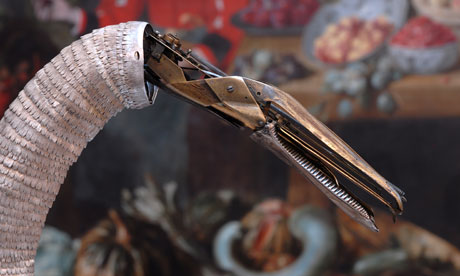
It couldn't happen to a nicer museum. The Bowes at Barnard Castle is enjoying a warm bath of free and generous publicity through the talents of Peter Carey, one of only two novelists to win the Booker Prize twice.
Over a year ago, he contacted Dr Jane Whittaker, the principal keeper of the huge treasure trove in county Durham, to check information about mechanical automatons which play a central role in his new book The Chemistry of Tears.
Warmly reviewed by Andrew Motion in the Guardian last week the story involves a fictional parallel of the wonderful mechanical swan at the Bowes whose brief and beautiful performance holds everyone who watches transfixed. Carey had read of this and wanted to make sure that his own, highly inventive story was rooted in realistic descriptions.
Whittaker and Bowes curator Howard Coutts helped him all they could and also referred him to Matthew Read, the expert horologist who led the recent conservation and repair work which has brought the swan to a state almost matching its condition when new. Read is a tutor and programme leader for the conservation of clocks at his alma mater West Dean college in West Sussex, which also gets a mention in Carey's book.
All three dealt with a long list of questions about the stripping down and cleaning of the swan, whose extraordinarily realistic preening and seizing of a small fish have appeared in literature before. In 1869, Mark Twain in The Innocents Abroad describes how:
I watched the Silver Swan, which had a living grace about his movement and a living intelligence in his eyes - watched him swimming about as comfortably and unconcernedly as it he had been born in a morass instead of a jeweller's shop - watched him seize a silver fish from under the water and hold up his head and go through the customary and elaborate motions of swallowing it..
Carey's many references include this passage which describes the swan's mechanism with both beauty and precision:
As the boy from Eton wound the easy mechanism I could smell the sweet light mineral oil. When he withdrew the crank the glass rods rotated . . . Henry your silver swan was beautiful and pitiless as it turned its head to the left, towards the minister, then to the right towards the man from the Guardian, (Thank you for that too - Ed) and then it set to preen and clean its back. Every eerie movement was smooth as a living thing, a snake, an eel, a swan of course. As it twisted to look into one's eyes, its own stayed darkest ebony until, at that point when the sun caught the black wood, they blazed. It had no sense of touch. It had no brain. It was as glorious as God. The fish were 'sporting'. The swan bent its snakelike neck, then darted, and every single human being held its breath.
Carey also used the online update of the Swan conservation, which is still on the Bowes website, and adapted the name of the real automaton's Paris jeweller M.Samper for a German automaton specialist in the novel called Sumper.
Whittaker says:
Staff here were impressed with Mr Carey's attention to detail and amazed by the similarities between the fictional Swan and our own automaton, including references to the twisted glass rods which give the impression of moving water, and the 'swimming' fish. Since the completion of conservation, our Silver Swan is looking wonderful, operating smoothly, and continuing to delight visitors of all ages with its performance. We are thrilled to have been of assistance to Peter and to have the kudos of our automaton being recognised in what I'm sure will be a bestselling novel.
Carey in turn has made handsome acknowledgments of the trio's help and the wonders of one of northern England's great museums.
Here's a YouTube film of the restored swan in action in February.

